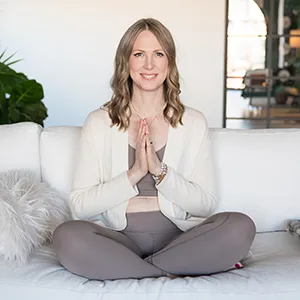What if there was Pilates for POTS?
Oct 14, 2025
You may be thinking…are you serious? Another recommendation to “just exercise” your way out of illness or pain? You’re not alone if you feel skeptical, or even frustrated, by that often unsolicited suggestion.
You might hear that exercise is necessary for feeling better, but no one explains how to move safely when even standing up can trigger dizziness or fatigue. Let’s be clear: exercise isn’t a cure, and it’s not a replacement for medical care.
If your concerns have been dismissed, please hear me loud and clear, you deserve to be taken seriously no matter how much (or how little) you exercise.
With that said, gentle, well-paced movement can be an empowering way to support your body, and Pilates offers one of the most adaptable paths to do just that.
In Support of Moving Your Body
Living with POTS means symptoms can flare anytime, anywhere. Life often feels unpredictable and complicated, especially when it comes to exercise. That unpredictability alone can stop you before you even get the chance to begin.
Traditional exercise programs can make you feel worse because they often focus on intensity, high heart rates, and heavy loads. But if you live with POTS, those very things -rapid changes in position, heat, or overexertion-can be exactly what triggers symptoms.
Pilates takes a different approach. It’s about controlled, mindful movement, breathwork, and building strength from the inside out. You can work at your own pace, in positions that feel safe, while improving your ability to regulate your nervous system.
You can think of it as a conversation with your body rather than a command.
In Support of Adaptability
One of the most empowering things about Pilates is how customizable it is. You can adjust almost every exercise to meet your ever-changing needs.
Position: Supine, seated, or standing, depending on your symptoms that day.
Support: Using Pilates equipment or props like a chair, wall, ball, or resistance band to stabilize or assist.
Chain type: Closed-chain movements (like pressing your feet into the floor or wall) help ground your body and reduce dizziness.
Open-chain movements (like lifting an arm or leg) can gently challenge coordination and stability once you’re ready.
Energy: Rather than falling into the push-crash cycle, micro-exercising offers a way to stay within your working level while gently and safely progressing your growth edge. Consistency is more effective than intensity.
Breath: When breath and movement flow in synchronicity, you move out of being “just in your head” and into sensing your body.
Pilates can be modified as you need it. You can adapt it to support what your body needs in the moment and gradually add challenge when you are ready.
In Support of Pacing
Every day with POTS is different. Some days, just standing for a few minutes feels like a workout.
This is where one of the most important questions comes in when you are starting out and even when you have a developed practice: “Is today a pace day or a push day?”
A "pace" day is to keep you steady and help you maintain your working level, while a "push" day is to build capacity or expand your growth edge.
Pilates lets you gently do both. The choice is yours, allowing you to bridge the discrepancy between where you are and where you want to be without overwhelm.
In Support of Nervous System Regulation
In POTS, the autonomic nervous system can easily become stuck in a sympathetic nervous system “fight or flight” state. It is often referred to as survival mode. Pilates helps activate the parasympathetic system (rest and digest state), promoting calm, balance, and recovery. This is often called the healing state.
It’s not about doing more or working harder, it’s about befriending your body. When you learn to listen to your body’s signals and engage in a conversation, you can begin to respond to what you notice. With practice, you may feel more connected to your body and aware of its cues. As this happens, you start to recognize how you shift between states, or when you’re more stuck in one than another.
In Support of Progression
In Pilates, progress doesn’t always come from high repetitions or heavy resistance—it comes from coordination and control.
This is a different kind of “progressive overload,” one that respects where you are and where you want to be without forcing it. It’s about rebuilding the idea of “I can” in a body that’s often met with “I can’t.”
I like to think of a three-phase approach to progress that helps protect you from overdoing it. If the exercise is comfortable and you are coordinated doing it, that’s when you can safely begin to challenge yourself. In other words: before you increase difficulty, make sure the movements feel both comfortable and coordinated.
In Support of You
If you’ve tried to exercise before and it made things worse, I see you. It’s not your fault. What you need isn’t to push harder, it’s to move smarter.
If you are curious about how to start safely, Pilates can be your gentle entry point back to movement. It’s adaptable, mindful, and supportive. You can start from a chair, the floor, or a mat.
So, ask yourself now: “Is it a pace day or a push day?”
Whichever it is, there’s a way to move that honors exactly where you’re at and supports where you want to go next.
You might just find that movement can feel good again.
Stay Connected
Learn to move and live with ease in a pain-free body:


